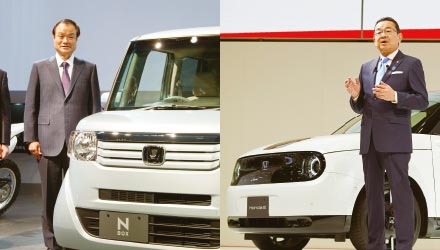Honda’s Challenge to Become Japan’s
First Automaker to Manufacture Locally
Honda’s local production of automobiles began in the United States. In 1978, Honda of America Manufacturing (HAM) was established in Marysville, Ohio, and production of motorcycles began the following year in 1979, but planning for automobile production was already in motion.
The United States was Honda’s largest market at the time. The “You Meet the Nicest People on a Honda” advertising campaign that began in the mid-1960s had boosted motorcycle sales steadily, and the Civic with a CVCC engine, which Honda began selling in 1975, was a huge hit. Against this backdrop, Honda’s decision to begin local production in the U.S. represented a quantum leap in the company’s overseas expansion.
However, at a time when the yen was weak against the dollar, it was more appropriate to increase production in Japan and increase exports from a general management standpoint. The results of a market survey conducted when the company was considering expansion also predicted that the plant would cause a deficit.
Nevertheless, Honda decided to take on this risk and try local production in the U.S., which no other Japanese automaker was doing at the time, based on its principle of “building products close to the customer.” HAM was established, and when it acquired the site for its motorcycle plant, it had also acquired the site for its automobile plant. The year after the motorcycle plant began operations, construction of the automobile plant began, and in 1982, Honda’s first overseas production of automobiles by a subsidiary began.
The establishment of HAM was also intended to thoroughly implement its “four localization” principles:
Localization of people: Honda’s expatriates would be integrated into the local society, and at the same time, management itself would be localized by hiring local associates and actively appointing them to key positions.
Localization of products: Honda would supply products that fully meet the needs of local customers and society.
Localization of money: Reinvesting profits earned locally to the maximum extent possible, further expanding local activities.
Localization of Components: Contribute to local communities by increasing the cost competitiveness of local procurement and overseas production plants, helping to foster local industries, and increasing employment opportunities.
Honda considered that its future lies in coexistence and co-prosperity, developing together with local communities through the promotion of these localization principles.
Honda’s First Locally Manufactured Car,
the Accord, Rolls Off the Line
Honda had one concern when it began local production of automobiles at HAM, the first time a Honda overseas subsidiary had done so. It was worried about the unknown: whether it would be possible to manufacture products in the U.S. with the same quality as Japan.
Production of motorcycles had progressed steadily in the first year of operations, including production of the CBX1000 and the Gold Wing GL1100 large motorcycles, and the quality of the U.S. products had been recognized as being comparable to those made in Japan. However, when it came to the production of automobiles, the number of parts, configuration, and manufacturing process were completely different. Would Honda be able to make it work?
Honda decided to conduct a simulation in Japan of production at HAM. The Accord prototype was built at the Suzuka Factory with parts made in the U.S.A. and subjected to rigorous checks. Its feel was satisfactory. Honda was confident that the quality would be maintained by HAM associates*1 who had undergone training and proficiency in the field. In 1982, when the automobile plant was completed, the first Accord produced in the U.S. rolled off the production line.

Line-off for HAM’s first Accord
HAM then began production of motorcycle engines at the Anna Engine Plant, which began operations in 1985. In 1986, production of the Civic at the Marysville Plant and automobile engines at the Anna Plant also began. In the same year, Honda of Canada Manufacturing (HCM), a production facility established in Canada, began production of the Accord, and in 1989, HAM built its East Liberty plant, its second plant for complete automobiles, and dramatically expanded its production system in the North American region.
- Honda subsidiaries outside of Japan call their workers “associates,” to emphasize their belonging to a group of people who work together to achieve a common goal.

Marysville Plant automobile production line (HAM)

Anna Plant automobile production line (HAM)
Cooperative Relationship to Global Network Base in Europe
In 1992, a European version of the Accord rolled off the production line at Honda of UK Manufacturing (HUM), a completed vehicle plant in Swindon, Wiltshire, England. This was Honda’s first production of automobiles in Europe at its own plant, but the path to establishing HUM and the production of completed vehicles had begun, unexpectedly, more than 10 years earlier.
In 1980, Honda signed a licensing production technology agreement at the suggestion of British automaker British Leyland (BL). The agreement was that Honda would provide its production machineries and equipment to BL’s plant, and BL would produce and market Honda’s small car, the Ballade, under the BL brand name, Triumph Acclaim.
At the time, BL was struggling in the midst of a fierce competition for market share in Europe and was looking for a tie-up with a Japanese manufacturer that had the technological capability to develop compact cars. The British ambassador to Japan, acting on behalf of then Prime Minister Thatcher, who had pledged to privatize BL, approached Honda concerning a partnership. While other Japanese automakers had declined, Honda saw this as an opportunity. The European compact car market was tough, with fierce competition from powerful European manufacturers in the UK, Germany, France, and elsewhere. Moreover, Honda was struggling to gain market share because import restrictions limited the number of vehicles it could export. Honda believed that the partnership with BL would be an opportunity to make a long-term strategic move in their European business.
Honda and BL continued to deepen their cooperation, signing a joint development agreement for the Honda Legend and BL Rover 800 in 1983, and a joint manufacturing agreement in 1984 to produce the Rover 800 and Europe-model Legend at BL’s plant, and the Rover 800 (Rover Sterling) for Japan at the Saitama Factory’s Sayama Plant. This led to the establishment of HUM in 1985 and the joint development of the Honda Concerto Rover 200, for which HUM built an engine plant in 1989 to produce and supply Honda engines for the Rover 200.
The partnership with Austin Rover Group (renamed ARG from BL) was further strengthened, and a memorandum of understanding was signed in 1989 for the construction of an automobile plant at HUM. This established Honda’s production system for completed vehicles in the U.K., and production of the European version of the Accord began in 1992.

HUM’s Accord, Honda’s first automobile produced in Europe, rolling off the production line
 Automobile production line at the Swindon plant(HUM)
Automobile production line at the Swindon plant(HUM)
However, in 1994, after a period of solid cooperation, ARG was acquired by BMW of Germany. At that time, HUM was planning to produce Honda brand vehicles based on ARG’s four-wheel drive vehicles and export to and sell them in Japan, but the plan was now in limbo. Honda then decided to take on the European market on its own.
Around 2000, Honda began a complete overhaul of its production system and sales network in Europe, including the addition of a second plant at HUM and a major expansion of its production system. In addition to the production of the CR-V for Europe, which began in 2000, the first plant also began to produce the CR-V for North America. On the second line, production of the Civic for Europe began in 2001. Honda had taken advantage of the weak euro at the time, while also incorporating HUM into Honda’s global network as a European base.
Expanding Production into Asia, Furthering its Globalization
Honda’s automobile production in Asia began in 1969, when the company entered into a technical collaboration with a local Taiwanese company and began its first overseas production. In 1983, Honda established Honda Cars Thailand (HCT), a sales company for automobiles in Thailand, and outsourced production to Bangchan General Assembly Co., Ltd. (BGAC). Japanese, Australian, and European automakers had already been active in Thailand for more than a decade, and Honda was a latecomer.
At the time, the Thai government had imposed many restrictions on the auto industry, with no new car manufacturing plants allowed and restrictions on the total number of models assembled. The overall size of the automobile market was approximately 90,000 units per year, but most of the market was dominated by commercial vehicles, and Honda entered the passenger car market with a mere 20,000 units per year, extremely small compared to current production.
As Honda was a latecomer to the automobile market, it was not well known and did not offer commercial vehicles. The founding members of HCT decided that their basic strategy was to turn these weaknesses into strengths. As HCT would only sell passenger cars, it was going to create a sales environment focused on passenger car customers and become the most customer-oriented company in Thailand. In the late 1980s, the market expanded with Thailand's economic growth, and Honda’s sales grew steadily.
In the 1990s, the Thai government finally gave Honda permission to manufacture passenger cars, and in 1992, Honda purchased Fiat’s dormant plant in Min Buri, the same district as BGAC, and established Honda Cars Manufacturing Thailand (HCMT)*2. With this move, Honda established its own production system in Thailand, and at the same time, established an important base for its regional strategy in Asia.
HCMT's Min Buri plant was small in scale, so it produced the Civic, while Accord production continued at BGAC. However, plans developed for the small plant to manufacture the City, a model being developed exclusively for the Asian market.
The original plan was to start production in Suzuka and shift to Thailand six months later. However, the decision was made to start production in Thailand, taking into consideration the fact that if the production was started in Japan, it would not benefit from the taxation system through the mutual complementing of parts in ASEAN*3 nations, and that cost reductions could be achieved through thorough localization. However, the Min Buri plant at the time was too small, with a daily production limit of 60 units, and could not accommodate the line development, testing, quality control, and local procurement*4 required for the new plant.

Ayutthaya Plant (HCMT, HATC from December 2000)
 Automobile production line at HATC’s Ayutthaya Plant
Automobile production line at HATC’s Ayutthaya Plant
A new HCMT plant was built in Thailand’s ancient Ayutthaya district, where many Japanese companies already had plants, and production of the City began in 1996. The production capacity was 60,000 units per year. This was more than double the production potential of the Min Buri plant and BGAC combined. At first, many were concerned about whether the City would sell with that much production, but it became such an explosive hit that production could not keep up. The Ayutthaya plant later played a major role as a production base in Asia, exporting components to Malaysia, Indonesia, the Philippines, and several other countries that produced the City.
Honda's global production system for automobiles had expanded from Japan into four regions (North America, Europe, and Asia), and the company began to make efforts to manufacture cars that best meet the needs of customers in each region on a global scale.
- Merged with Honda Cars (Thailand) in December 2000, forming Honda Automobile (Thailand) Co., Ltd. (HATC)
- Association of South-East Asian Nations
- High local procurement rate was required.





